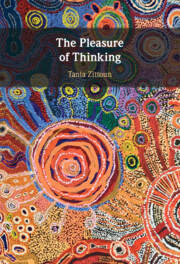Book contents
- The Pleasure of Thinking
- The Pleasure of Thinking
- Copyright page
- Dedication
- Contents
- Figures
- Foreword
- Chapter 1 The Pleasure of Thought
- Chapter 2 On the Emergence of Pleasurable Thinking
- Chapter 3 Thinking the Pleasures with Psychoanalysis
- Chapter 4 Thinking in Sociocultural Psychology
- Chapter 5 Thinking through the Psyche
- Chapter 6 The Pleasure of Thinking in Diverse Experiences
- Chapter 7 Trajectories of Pleasures in Thinking
- Chapter 8 Thinking Forward
- Notes
- References
- Index
Chapter 2 - On the Emergence of Pleasurable Thinking
Published online by Cambridge University Press: 05 October 2023
- The Pleasure of Thinking
- The Pleasure of Thinking
- Copyright page
- Dedication
- Contents
- Figures
- Foreword
- Chapter 1 The Pleasure of Thought
- Chapter 2 On the Emergence of Pleasurable Thinking
- Chapter 3 Thinking the Pleasures with Psychoanalysis
- Chapter 4 Thinking in Sociocultural Psychology
- Chapter 5 Thinking through the Psyche
- Chapter 6 The Pleasure of Thinking in Diverse Experiences
- Chapter 7 Trajectories of Pleasures in Thinking
- Chapter 8 Thinking Forward
- Notes
- References
- Index
Summary
The best way to characterise the pleasure of thinking is to retrace its development. Chapter 2 thus approaches the pleasure of thinking from the perspective of developmental psychology. After a presentation of the meta-theoretical frame of a sociocultural, constructivist, developmental approach, the chapter first presents the classical observations made by Charles Darwin and Jean Piaget, both of whom identified manifestations of pleasure in young children. Second, the chapter examines the literature based on close analysis of parent-infant observations, which shows that from 3 or 4 months of age, children may experience playfulness, a shared pleasure in humorous situations, and the positive experience of being the author of their actions. Third, it presents literature on curiosity, humour, and interests in the preschool years, which reveals that children’s curiosity can be cultivated into interests. In school years, fourth, pleasure is often considered at the margin of the classroom, but also in relation to mathematics and, incidentally, in interactions. In the final section, the chapter rereads longitudinal data, retracing the conditions in which children may develop pleasure in learning and thinking.
Keywords
- Type
- Chapter
- Information
- The Pleasure of Thinking , pp. 40 - 93Publisher: Cambridge University PressPrint publication year: 2023



